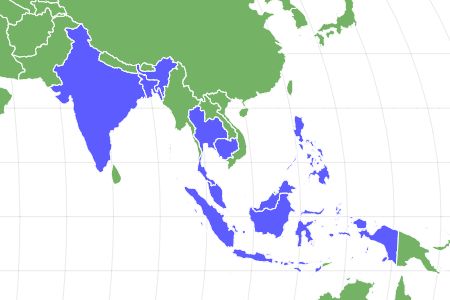Paradise Flying Snake
Chrysopelea paradisi
Paradise Flying Snakes can glide over 100 yards!
Advertisement
Paradise Flying Snake Scientific Classification
- Kingdom
- Animalia
- Phylum
- Chordata
- Class
- Reptilia
- Order
- Squamata
- Family
- Colubridae
- Genus
- Chrysopelea
- Scientific Name
- Chrysopelea paradisi
Read our Complete Guide to Classification of Animals.
Paradise Flying Snake Conservation Status
Paradise Flying Snake Facts
- Prey
- Small mammals, reptiles and amphibians
- Name Of Young
- Hatchlings or snakelets
- Fun Fact
- Paradise Flying Snakes can glide over 100 yards!
- Estimated Population Size
- Unknown, but widespread and stable
- Most Distinctive Feature
- Their vibrantly colored diamond-shaped pattern
- Distinctive Feature
- They have rear fangs instead of front fangs like most venomous snakes.
- Other Name(s)
- Paradise tree snake, paradise gliding snake, and garden flying snake
- Diet
- Carnivore
- Common Name
- Paradise Flying Snake, Paradise Tree Snake, Paradise Gliding Snake, Garden Flying Snake
Paradise Flying Snake Physical Characteristics
- Skin Type
- Scales
- Venomous
- Yes
- Aggression
- Medium
View all of the Paradise Flying Snake images!
The paradise flying snake, also commonly known as the paradise tree snake, is a mildly venomous constrictor found throughout southeast Asia.
The most notable feature of the paradise flying snake is that, as its name suggests, it is capable of a sort of gliding flight. These snakes can jump from treetops and manipulate their bodies in such a way as to float maximum distances of just over 300 feet. Their slim-sized round bodies flatten out as they launch themselves from limbs down onto prey below. They are a type of mildly venomous constrictor who feeds mostly on very small animals.
5 Paradise Flying Snake Amazing Facts
- Paradise Flying Snakes can glide over 100 yards.
- Paradise tree snakes can control their fly by undulation.
- Paradise flying snakes are both mildly venomous and a constrictor, who can swallow their prey whole.
- Paradise tree snakes have a set of fixed rear fangs to inject venom instead of the front set venomous snakes normally have.
- Paradise flying snakes are found in habitats across more than 10 countries.
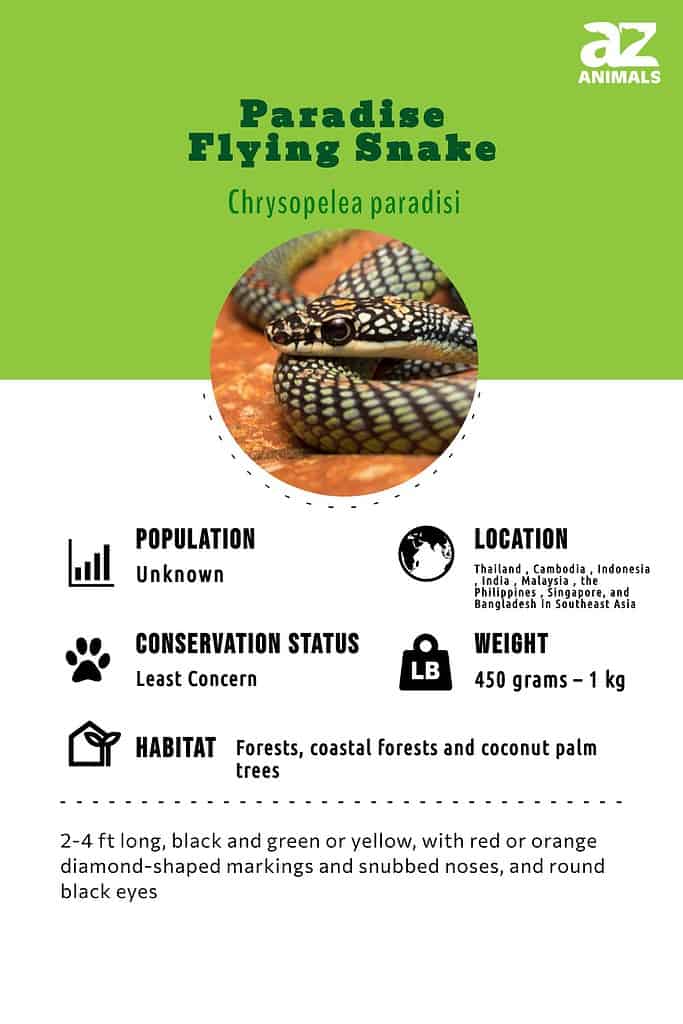
Where To Find Them
The paradise tree snake habitat is moist and wooded. This snake enjoys the forests, coastal forests and coconut palm trees of Thailand , Cambodia , Indonesia , India , Malaysia , the Philippines , Singapore, and Bangladesh in Southeast Asia . They spend a lot of time in or around trees, as well as hiding in holes or under logs. They are likely to be in places where lizards and frogs are abundant, as those are their most common prey, and places where trees are somewhat closely gathered.
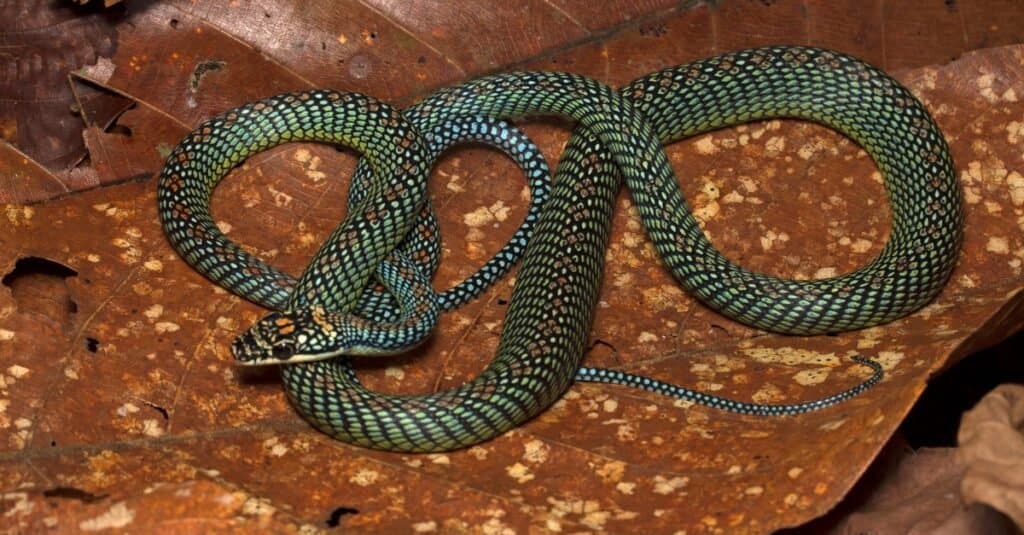
Paradise Flying Snakes live in forests, coastal forests, and coconut palm trees.
©Vince Adam/Shutterstock.com
Scientific Name
The scientific name for the paradise flying snake is Chrysopelea paradisi. It is also known as the paradise tree snake, paradise gliding snake, and garden flying snake. “Paradisi” roughly translates in Latin and Greek to “park” which is likely where this snake was first discovered. The etymology of “Chrysopelea” is unknown, but refers generally to flying or gliding snakes. There are many species and subspecies which have been identified and then re-identified as something else or identified twice as separate species so that it is hard to distinguish which are the primary, true species, and subspecies.
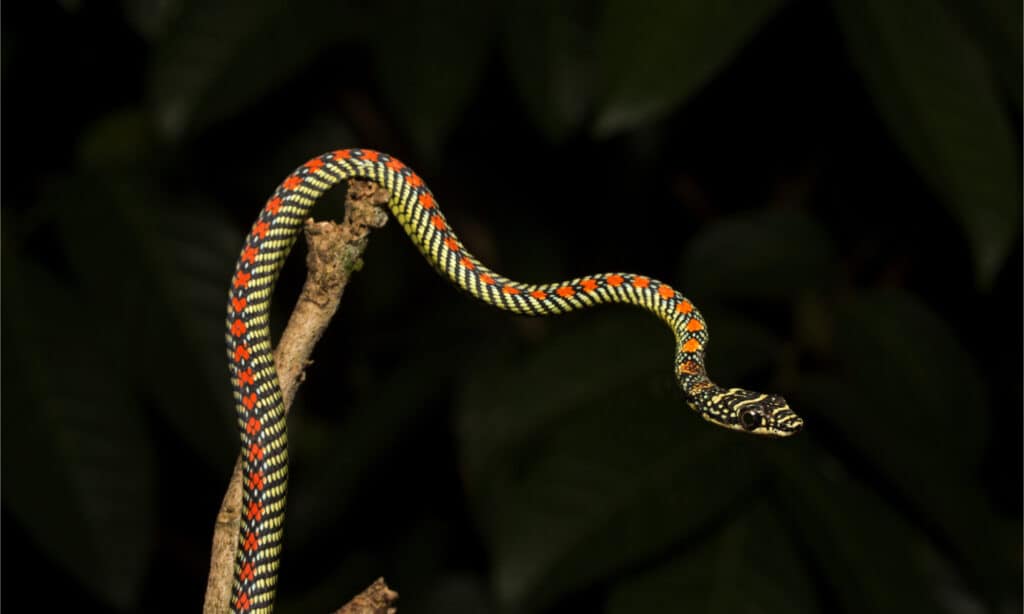
The scientific name for the paradise flying snake is
Chrysopelea paradisi.
©Vince Adam/Shutterstock.com
History and Evolution
It is interesting to think about how a snake has been able to evolve into a glider. We often think of snakes slithering on the ground or dangling from a tree, but not this snake! It is actually only one of a handful of animals in the world that are capable of gliding.
The main thought on how and why this snake adapted the ability to glide is to avoid predators. You can not eat what you cannot catch! There also may be some clues to the evolution based on other animals that live near them, such as Flying Frogs and Gliding Lizards.
In flight, these snakes are able to expand their ribs to achieve twice the body width. This helps keep them aloft, as well as undulating to help steer towards their landing target. Furthermore, these reptiles perch into a “J” shape before springing off a high branch to get the most from their launch.
Population and Conservation Status
The paradise tree snake was assessed for the ICUN Red List in 2011 and found to be of Least Concern (LC). Their population, which spans several countries in Asia, is listed as stable. More assessment and study is likely needed, but they are not in danger at this time and their population appears abundant. These flying snakes have very common and readily available prey, they stay out of the way of most predators by virtue of their tree habitation and they are not very common in the pet trade, so as long as their habitat is somewhat protected, they remain out of danger of extinction.
Appearance and Description
A paradise flying snake is black and green or yellow, with diamond-shaped markings along their backs which are often orange or red in color. Their underbellies are usually solid greenish-yellow. Their heads have a series of horizontal black stripes and then the pattern changes at their neck. They have snubbed noses, and round black eyes, large compared to the size of their heads. The tail of a paradise tree snake is very thin compared to the rest of its body. They are only about two to four feet long in size and quite slim when not flying through the air. Females tend to be much larger than males of the species.
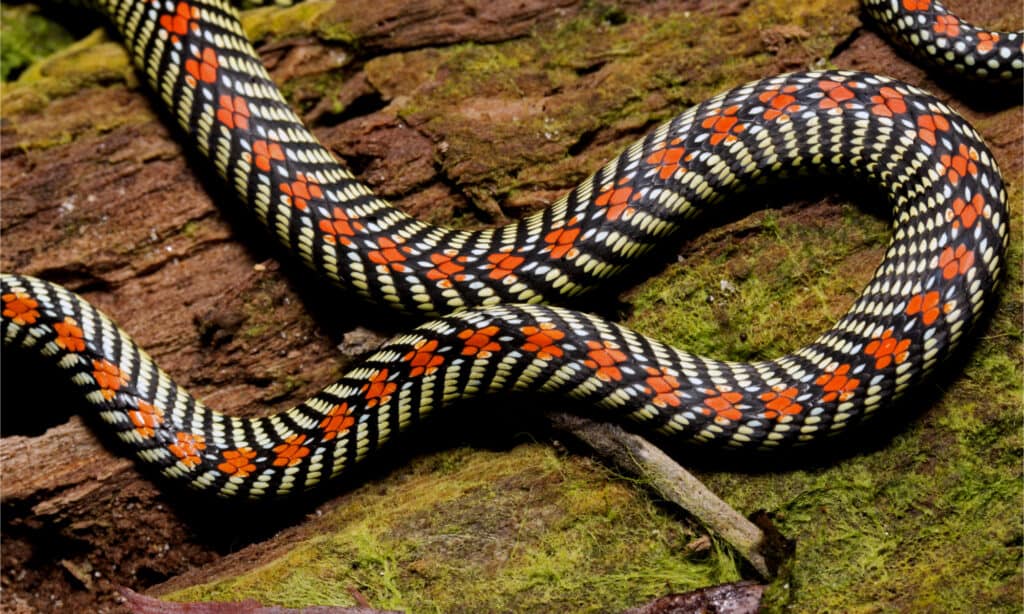
Paradise flying snakes have vibrantly colored diamond-shaped markings.
©Vince Adam/Shutterstock.com
How Dangerous Are They?
The paradise tree snake has a relatively small mouth and only has fixed rear fangs and a mildly toxic venom, which means they do not pose much danger to humans. A few human finger bites have been reported, but no ill effects of the venom were reported. Such cases are extremely rare and would require a specific set of circumstances to occur. They also do not forcibly inject venom the way that species with front fangs do, instead, the venom is dripped into the wounds, making them less of a threat for anyone accidentally bitten.
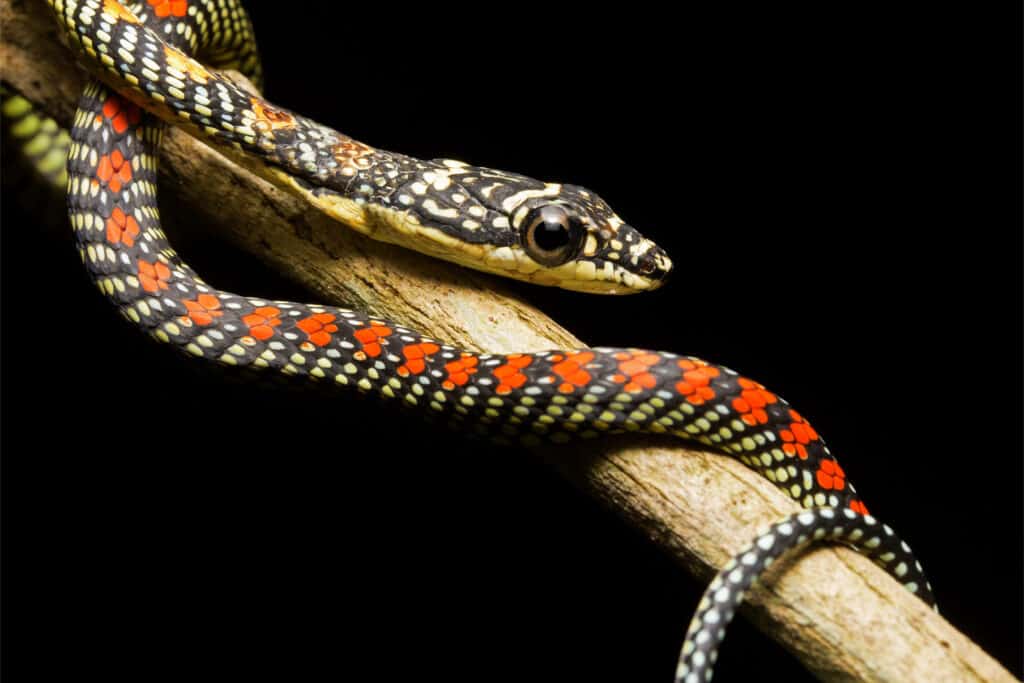
Paradise Flying Snakes do not pose much danger to humans.
©Vince Adam/Shutterstock.com
Behavior and Humans
There are some people who keep paradise flying snakes as pets, however, this is only an activity for a highly experienced snake owner. They require treatment for parasites upon receipt since captive breeding is rare and most pets are wild-caught specimens. They also require a lot of floor space, careful humidity monitoring, a lot of height in their enclosures, and live feeding of lizards and frogs, both of which also periodically need to be treated against parasites. All in all, they are a difficult breed to keep as pets and are therefore only recommended for owners with a significant amount of training and knowledge in snake keeping.
View all 192 animals that start with PParadise Flying Snake FAQs (Frequently Asked Questions)
Are paradise flying snakes venomous?
A paradise tree snake is mildly venomous, but their tiny fangs make it nearly impossible for them to inject venom into a human, though there have been reports of human finger bites.
Are paradise flying snakes good pets?
Some people do keep the paradise tree snake in captivity, but due to their need for height and hunting, they are not good beginner or even intermediate pets.
Can the paradise tree snake fly?
A paradise flying snake cannot take flight from the ground into the air, but they can jump down from a tree in a sort of gliding flight, not unlike that of a flying squirrel
How far can the paradise flying snake fly?
A paradise tree snake can glide quite far, reaching distances of up to 100 yards with their glides.
Are paradise tree snakes deadly?
Paradise flying snakes are only deadly to the lizards and frogs and other small animals which make up their prey, and not to humans.
Where are paradise flying snakes found?
Paradise tree snakes can be found in the forests in 10 countries in Southeast Asia, including Indonesia, India, Malaysia, and Singapore.
Thank you for reading! Have some feedback for us? Contact the AZ Animals editorial team.
Sources
- Wikipedia / Accessed May 10, 2022
- Ecology Asia / Accessed May 10, 2022
- Thai National Parks / Accessed May 10, 2022
- Wild Singapore / Accessed May 10, 2022
- Animals Mom / Accessed May 10, 2022
- ABC7 / Accessed May 10, 2022
- NPR / Accessed May 10, 2022
- Britannica / Accessed May 10, 2022
- Bio Web (1970) http://bioweb.uwlax.edu/bio203/s2009/houk_step/Aerial Adaptations.htm / Accessed May 10, 2022
- Community Morph Market / Accessed May 10, 2022

